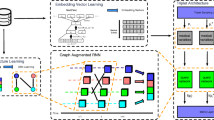Abstract
The rapid growth in the use of electronic health records (EHR) offers promises for predicting patient outcomes. Previous works on this task focus on exploiting temporal patterns from sequential EHR data. Nevertheless, such approaches model patients independently, missing out on the similarities between patients, which are crucial for patients’ health risk assessment. Moreover, they fail to capture the fine-grained progression of patients’ status, which assist in inferring the patients’ future status. In this work, we propose a similarity-aware collaborative learning model SiaCo for patient outcome prediction. In particular, we design two similarity measurers and two global knowledge matrices to separately calculate the similarity of patients with different information levels and support collaborative learning between patients. To capture the more fine-grained progression of patients’ status, we design a parallelized LSTM to model the temporal-dependent patterns of patient status. Finally, SiaCo integrates the information learned from two measures and the parallelized LSTM to predict patient outcomes. Extensive experiments are conducted on two real disease datasets. The experimental results demonstrate that SiaCo outperforms the state-of-the-art models for two typical tasks of patient outcome prediction.
Access this chapter
Tax calculation will be finalised at checkout
Purchases are for personal use only
Similar content being viewed by others
References
Baytas, I.M., Xiao, C., Zhang, X., Wang, F., Jain, A.K., Zhou, J.: Patient subtyping via time-aware LSTM networks. In: SIGKDD, pp. 65–74 (2017)
Bhattacharya, S., Rajan, V., Shrivastava, H.: ICU mortality prediction: a classification algorithm for imbalanced datasets. In: AAAI, pp. 1288–1294 (2017)
Cai, X., Gao, J., Ngiam, K.Y., Ooi, B.C., Zhang, Y., Yuan, X.: Medical concept embedding with time-aware attention. In: IJCAI, pp. 3984–3990 (2018)
Cheng, Y., Wang, F., Zhang, P., Hu, J.: Risk prediction with electronic health records: a deep learning approach. In: SIAM, pp. 432–440 (2016)
Choi, E., et al.: Multi-layer representation learning for medical concepts. In: SIGKDD, pp. 1495–1504 (2016)
Choi, E., Bahadori, M.T., Song, L., Stewart, W.F., Sun, J.: GRAM: graph-based attention model for healthcare representation learning. In: SIGKDD, pp. 787–795 (2017)
Choi, E., Bahadori, M.T., Sun, J., Kulas, J., Schuetz, A., Stewart, W.F.: RETAIN: an interpretable predictive model for healthcare using reverse time attention mechanism. In: Advances in Neural Information Processing Systems, vol. 29, pp. 3504–3512 (2016)
Choi, E., Schuetz, A., Stewart, W.F., Sun, J.: Medical concept representation learning from electronic health records and its application on heart failure prediction. arXiv (2016)
Choi, E., Xiao, C., Stewart, W.F., Sun, J.: MiME: multilevel medical embedding of electronic health records for predictive healthcare. In: Advances in Neural Information Processing Systems, vol. 31, pp. 4552–4562 (2018)
Gao, J., Xiao, C., Wang, Y., Tang, W., Glass, L.M., Sun, J.: StageNet: stage-aware neural networks for health risk prediction. In: Proceedings of the Web Conference (WWW), pp. 530–540 (2020)
Hochreiter, S., Schmidhuber, J.: Long short-term memory. Neural Comput. 9, 1735–1780 (1997)
Johnson, A.E., et al.: MIMIC-III, a freely accessible critical care database. Sci. Data 3, 1–9 (2016)
Keogh, E.J., Pazzani, M.J.: Derivative dynamic time warping. In: Proceedings of the 2001 SIAM International Conference on Data Mining, pp. 1–11. SIAM (2001)
Kingma, D.P., Ba, J.: Adam: a method for stochastic optimization. In: Bengio, Y., LeCun, Y. (eds.) ICLR (2015)
Liu, L., Shen, J., Zhang, M., Wang, Z., Tang, J.: Learning the joint representation of heterogeneous temporal events for clinical endpoint prediction. In: AAAI, pp. 109–116 (2018)
Liu, N., Lu, P., Zhang, W., Wang, J.: Knowledge-aware deep dual networks for text-based mortality prediction. In: ICDE, pp. 1406–1417 (2019)
Ma, F., Chitta, R., Zhou, J., You, Q., Sun, T., Gao, J.: Dipole: diagnosis prediction in healthcare via attention-based bidirectional recurrent neural networks. In: SIGKDD, pp. 1903–1911 (2017)
Ma, L., et al.: AdaCare: explainable clinical health status representation learning via scale-adaptive feature extraction and recalibration. In: AAAI, pp. 825–832 (2020)
Ma, L., et al.: ConCare: personalized clinical feature embedding via capturing the healthcare context. In: AAAI, pp. 833–840 (2020)
Mahajan, R., Mansotra, V.: Predicting geolocation of tweets: using combination of CNN and BiLSTM. Data Sci. Eng. 6(4), 402–410 (2021)
Mikolov, T., Chen, K., Corrado, G., Dean, J.: Efficient estimation of word representations in vector space. In: ICLR (2013)
Umemoto, K., Goda, K., Mitsutake, N., Kitsuregawa, M.: A prescription trend analysis using medical insurance claim big data. In: ICDE, pp. 1928–1939 (2019)
Wang, F., Lee, N., Hu, J., Sun, J., Ebadollahi, S., Laine, A.F.: A framework for mining signatures from event sequences and its applications in healthcare data. IEEE Trans. Pattern Anal. Mach. Intell. 35, 272–285 (2012)
Wawrzinek, J., Pinto, J.M.G., Wiehr, O., Balke, W.: Exploiting latent semantic subspaces to derive associations for specific pharmaceutical semantics. Data Sci. Eng. 5(4), 333–345 (2020)
Yin, K., Qian, D., Cheung, W.K., Fung, B.C., Poon, J.: Learning phenotypes and dynamic patient representations via RNN regularized collective non-negative tensor factorization. In: AAAI, pp. 1246–1253 (2019)
Acknowledgements
This work is supported by the National Key R&D Program of China (No. 2021YFF0900800), the major Science and Technology Innovation of Shandong Province grant (No. 2021CXGC010108), the Fundamental Research Funds of Shandong University, and partially supported by the NSFC (No. 91846205).
Author information
Authors and Affiliations
Corresponding authors
Editor information
Editors and Affiliations
Rights and permissions
Copyright information
© 2022 The Author(s), under exclusive license to Springer Nature Switzerland AG
About this paper
Cite this paper
Yu, F., Cui, L., Cao, Y., Liu, N., Huang, W., Xu, Y. (2022). Similarity-Aware Collaborative Learning for Patient Outcome Prediction. In: Bhattacharya, A., et al. Database Systems for Advanced Applications. DASFAA 2022. Lecture Notes in Computer Science, vol 13246. Springer, Cham. https://doi.org/10.1007/978-3-031-00126-0_31
Download citation
DOI: https://doi.org/10.1007/978-3-031-00126-0_31
Published:
Publisher Name: Springer, Cham
Print ISBN: 978-3-031-00125-3
Online ISBN: 978-3-031-00126-0
eBook Packages: Computer ScienceComputer Science (R0)




